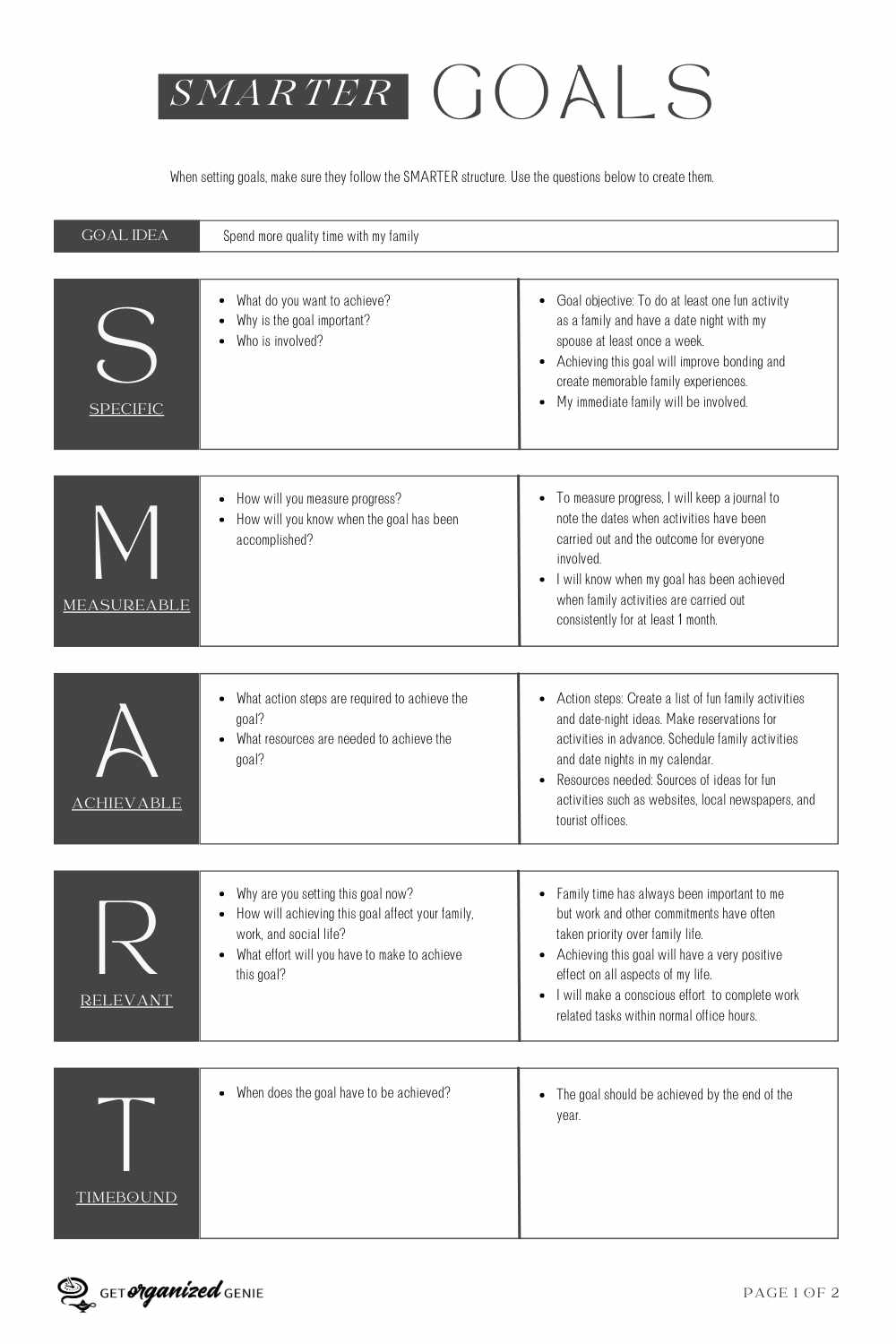- Home
- Habits of Organized People
- Setting SMART Goals
How To Set SMART Goals And Achieve Them | A Step-By-Step Guide
Having difficulty
achieving your goals? Learn how to set SMART Goals and craft a tailor-made plan
to achieve them right here!
With this comprehensive guide, you'll understand the concept of "SMART goals" and how to create them in easy steps to achieve successful results.
You can also download your SMART Goals Template and a completed example to create your goals with ease…these are FREE when you join the Genie VIP Club!
Contents:
- Why Are Goals Important?
- What is a SMART Goal?
- How to Set SMART Goals
- Download Your SMART Goals Template & Example
- Bottom Line
Read on to find out
more…

Why Are Goals Important?
Many of us spend our
lives rushing around trying to get things done but accomplishing very little.
Does that sound similar?
Setting goals gives us purpose, and helps us grow and maintain a positive mindset. It also helps us set the path and stay motivated to achieve what we want in life.
"The trouble with not having a goal is that you can spend your life running up and down the field and never score."
–Bill Copeland
What is a SMART Goal?
Achieving goals can
allow us to live a happier, more meaningful life, but the way we set them can
determine the likelihood of us achieving them!
A SMART Goal(1) uses a specific set of criteria for setting and achieving
goals. These criteria come from the mnemonic acronym SMART, which stands for: Specific,
Measurable, Achievable, Relevant, and Time-Bound.
Using the SMART criteria enables
you to set clear objectives and focus your efforts to increase your chances of
achieving success!

How to Set SMART Goals
When determining how to set SMART goals, you’ll need to find answers to the following seven
questions:
- What do I want to achieve?
- Why is the goal important?
- Who needs to be involved to help you achieve the goal?
- Which resources are required, or which obstacles can prevent the goal from being accomplished?
- How much of a particular thing must the goal achieve, and how will I achieve the goal ?
- When does the goal have to be achieved?
Let’s look at how you can use SMART criteria to set and achieve your goals in easy steps, without becoming overwhelmed or discouraged.
Step 1 - Identify your goals
The first step to setting SMART goals is to identify “what” it is you want to accomplish. This can be anything you have your sights set on, such as losing weight, becoming fit and healthy, organizing your home, or finding your dream job!
Regardless of the goal you set, make sure that it’s something that you feel passionate about and motivated to put your all into achieving it. Make sure that you are clear on the “why” behind achieving your goal. This will help you to stick with it, especially when faced with setbacks.
Step
2 - Make your goals specific
Once you have identified the ‘what’, it’s important to
make sure your goals are specific. Quantify what you want to achieve when
crafting your goal and put a real figure on it. Being specific gives you a real
target that you are more likely to achieve.
When deciding how to set SMART goals, it's best to use actionable verbs like learn, create, write, or launch. This will help you break the goal down into separate tasks and determine what resources would be required to ensure success.
Here are some examples you may use to make your goals specific:
- Lose 50 pounds before summer.
- Become fitter and healthier by exercising three times a week and eating balanced meals every day.
- Get a managerial job position next year.
Step
3 - Make
your goals measurable
When it comes to setting SMART goals, ensuring that
your goals are measurable is a vital step. Being able to measure your progress helps you to stay
focused and on track. It also lets you feel the excitement of getting closer to
achieving your goal, which motivates you to continue.
To set a measurable goal, ask yourself the following questions:
- What quantity should the goal achieve?
- How will I know when the goal has been accomplished?
An example of a measurable goal would be “to lose 50 pounds in 5 months”. In this case, you know that you have to lose 2.5 pounds each week to achieve your goal. You can check your weight at the end of each week to determine whether you are on track.
Another way to set a measurable goal is to break it down into smaller achievable tasks as follows:
- Write down each of the action steps required to achieve your goal.
- Put each step into sequential order.
- Set milestones for the completion of the most important steps.
If you set a goal to get a new job that requires additional skills, you could set the completion of the following milestones to measure your progress: Application for training courses, completion of training courses, CV update, job applications, interview preparation, etc.
Step 4 - Set achievable goals:
Set realistic goals,
otherwise, you will most certainly fail!
SMART Goals should stretch your abilities and provide a challenge, but they also need to be realistic and achievable. Without this key component, it’s very easy to become discouraged when attempting to reach a goal that is impossible to achieve.
To determine whether your goal is realistic, carry out the following steps:
- Define the steps you'll need to take to achieve your goal.
- Determine what resources you will need to carry out each of the steps required to achieve your goal. This may include money, physical items, tools, software, specific skills, assistance from other people, etc.
- If you don’t currently have the resources you need, determine what you’ll need to do to achieve them.
- Identify what obstacles can prevent you from achieving your goals and how you can overcome them.
Do you consider your goal achievable given the resources available and possible constraints?
If you don’t, reexamine your goal and make adjustments
to make sure that it is achievable.

Step 5 - Make it relevant:
Set goals that are
relevant to your overall objectives, what you want to achieve from life, and
your core values! Your goals must be meaningful enough for you to want them,
and be prepared to do whatever it takes to achieve them.
If a goal isn’t relevant or meaningful, then the efforts put into
achieving it will likely be wasted.
To ensure that your goal is relevant, you’ll need to be very clear on your reasons for wanting to achieve the goal.
You should also take into account your personal circumstances and other external factors that may be influenced on your journey toward achieving your goal:
- How will achieving your goal affect your family, work, or social life?
- How much effort will you have to make to achieve your goal?
- Will any sacrifices you’ll have to make be worthwhile?
Step
6 - Set a time frame for achievement
SMART
Goals should have a timeline to help you measure your progress and stay on
track to achieve them. It’s important to
set a reasonable timeline that allows you sufficient time to reach the goal,
but also holds you accountable and encourages timely completion.
Make sure that you break large goals into smaller goals (or tasks) with shorter deadlines so that you can track progress and make the necessary adjustments along the way.
If you want to achieve your goal in a year, break it down into monthly intervals so you know what you should achieve each month.
Step 7 - Monitor progress
and adjust as necessary
When setting SMART goals,
it's important to track your progress regularly to ensure you stay on track.
This will allow you to adjust your strategy if necessary to reach the desired
outcome.
Review your goals at least
weekly, and don’t be afraid to alter them according to changing circumstances
or changes in priority.

Download Your SMART Goals Template & Example | FREE with the Genie VIP Club!

Get your SMART Goals Template, SMART Goal Example, and monthly tips to boost productivity straight to your inbox…all for FREE when you join the Genie VIP Club.
Fill out the form immediately below and download your FREE Gifts TODAY!
You'll receive them in your inbox after joining.
BOTTOM
LINE
SMART goals are set using well-established criteria that require them to be Specific, Measurable, Achievable, Relevant, and Time-bound.
Using these criteria will ensure that you create clear, attainable, and meaningful goals, and help you set an action plan to track progress and stay on course.
Start living the life of your dreams…set your SMART goals TODAY!
Further Reading
Check out these articles to help you achieve some of the goals you may have set.
- SMARTER Goals Template and Example
- Habits of Organized People
- How to Organize Your Life in 3 Easy Steps!
- Getting Organized at Work - 4 Essential Tips for Success
- Tips for Organizing Your Home in 4 Easy Steps
References
2. Audio Book: The Goals and Vision Mastery Course by Les Brown, Jim Rohn, Zig Ziglar, Jack Canfield.
Share this with others by clicking the icons below!
